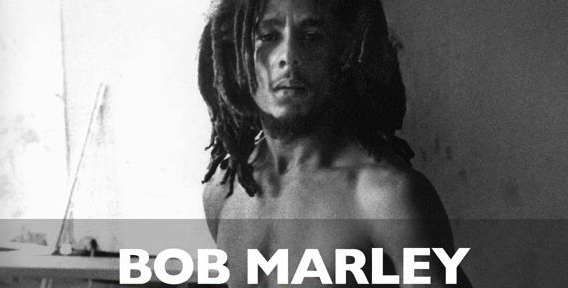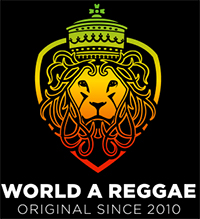World-A-Reggae recently spoke with legendary photographer Kim Gottlieb-Walker, who was one of the very first professional photographers to photograph Bob Marley, The Wailers, and other reggae musicians on their home turf in Jamaica. Her work is brilliantly presented in “Bob Marley and the Golden Age of Reggae: 1975-1976 The Photographs of Kim Gottlieb-Walker” with commentary by Cameron Crowe, Roger Steffens, and Jeff Walker. The book was published in August 2010 by Titan Books and Random House. It is available for purchase through Amazon and Barnes and Noble.
During 1975 and 1976, Kim Gottlieb-Walker, then an “underground photo-journalist,” accompanied her husband Jeff Walker, the Island Records publicity head, to Jamaica to profile this emerging movement of Rasta musicians who were making a brand new style of music called “reggae.” What she did not know at the time, and what we now know today, is that she documented the emergence of one of the greatest social, political, and musical revolutions of the past 50 years. Over a period of 2 years and several trips to Jamaica, Kim documented the artists who would go on to “define the genre and captivate a generation.”

Kim with Rohan Marley
(WAR) Talk a little bit about the first time you met Bob Marley. Was it at the Roxy in July 1975?
(KGW) “No…a few days earlier…Jeff and I met with Bob at his motel room where we set up the music press interviews. I set up the chair where Bob would sit during the interviews where the light would be good so I could shoot during the discussions without having to interject myself in any way. Bob knew we were there to spread the word about him and his message and he trusted Jeff, so he was completely on-board.”
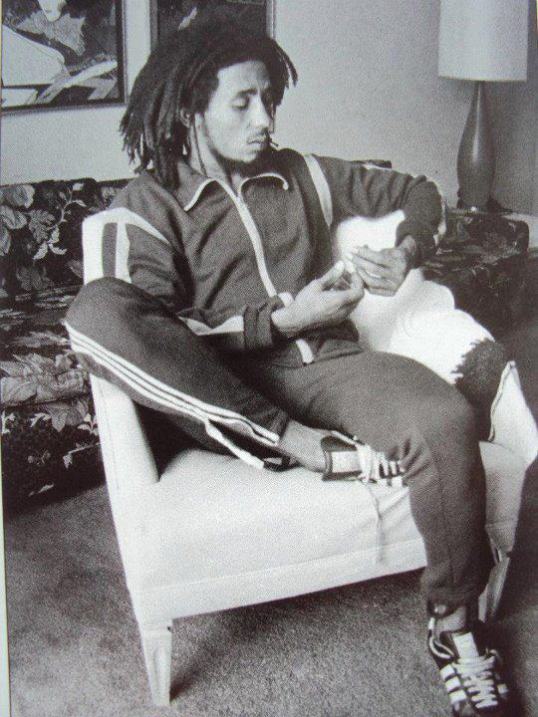
Bob before the music press interviews at the Sunset Marquis in Hollywood, 1975 (Photo © Kim Gottlieb-Walker, www.lenswoman.com, all rights reserved. From her book “Bob Marley and the Golden Age of Reggae, 1975-76, The Photographs of Kim Gottlieb-Walker.”)
(WAR) How about Peter Tosh? When did you first meet him?
(KGW) “I first met Peter at Tommy Cowan’s recording studio in Kingston. He was always open and loquacious and had absolutely justifiable righteous wrath about the injustices he had experienced…lots of verbal wordplay, very animated and expressive and enthusiastic about communicating his experiences and being photographed. We had such a good time with him and I enjoyed photographing him so much, that I was late getting over to Hope Road to Bob’s house…and Bob was just leaving to go play soccer and wouldn’t stick around, even though I had come to see him with Jeff a day or so earlier to let him know I was shooting for a People magazine article that would be seen by millions and so I wanted him to think about what he’d like the photo to say about him, what he’d like it to include, etc…but he drove off with his friends and I actually started to cry because it was an important assignment for me. I think his friends may have given him a hard time about it because they told me to come forward (never “back”) on Saturday to be there and hang out and take photos all day…which I did.”
(WAR) Tosh seems like such an imposing figure, however, I have heard that his personality was cordial and he was an easy man to talk to. What was your experience with him?
(KGW) “He was so genuinely sweet and open and expressive…the next year when we brought Cameron Crowe (at age 18) and our 3 year old son Orion (who Cameron dubbed Ras Kitty because he knew every cut on every reggae album Island had released and loved talking about his cats), Tosh was wonderful and gentle with Ry, helping him play 45s and getting a real kick out of Ry’s enthusiasm. And he went on an extended rant for Cameron about the injustice in Jamaica he had experienced…but always lively and funny and expansive…and REALLY fun to photograph.”
(WAR) Do you remember photographing Bob Marley for the first time?
(KGW) “It was in the West Hollywood motel room during and after the music press interviews…it was important to Bob to communicate that the music was just a vehicle for the message about Rastafari …about love and brotherhood and righteousness and equality…and he was very animated and expressive. I also photographed him relaxing with a spliff between interviews. Then we all went off to shoot the taping of the appearance on Manhattan Transfer…first a rehearsal and then the performance.”

Manhattan Transfer, 1975 (Photo © Kim Gottlieb-Walker, www.lenswoman.com, all rights reserved. From her book “Bob Marley and the Golden Age of Reggae, 1975-76, The Photographs of Kim Gottlieb-Walker.”)
(WAR) In photographing Marley, you captured many great moments, some in color and others in black and white. How do you decide which to use?
(KGW) “Color slide film was both expensive and had a narrow exposure range so I would mostly shoot black and white or Eastman Color Negative (which was actually 35mm movie film ends which were both cheap and produced color negatives with a wider exposure latitude from which you could make slides or prints – though the film was really meant for projection rather than print).”
(WAR) Was Marley agreeable to your following and photographing him?
(KGW) “He didn’t like to pose…but I was there to document what was there, not to pose him or interject myself…and he accepted my presence completely and graciously. When we were in his house at Hope Road, at one point I put some colored cardboard on the wall in the colors of the Ethiopian flag and asked him to stand in front of them…which he did…and the first photo was serious (he was trying to be patient even though he wasn’t 100% comfortable posing)…but I peeked out from behind the camera and said,”You know, a lot of people who will see these photos are people who already love you” and he broke out into a genuine smile which gave me my next two frames… and that was the end of that posing session. The only time he actually ENJOYED posing was for the High Times cover…that was genuine pleasure on his face!”
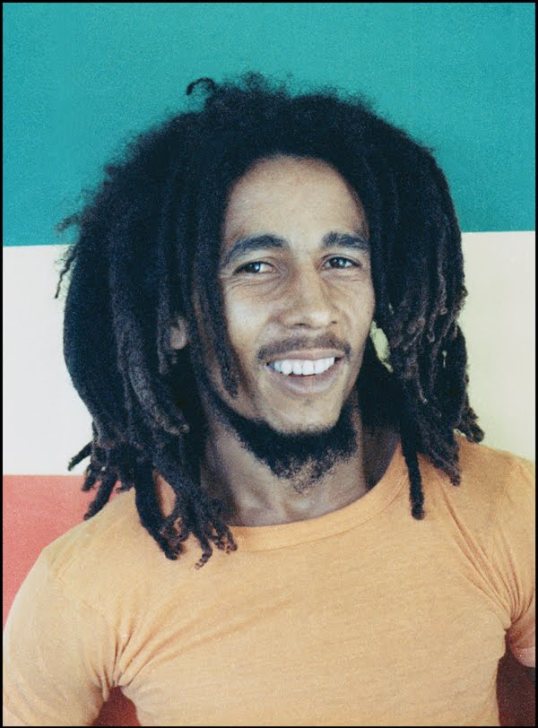
Bob smiles for Kim, 1976 (Photo © Kim Gottlieb-Walker, www.lenswoman.com, all rights reserved. From her book “Bob Marley and the Golden Age of Reggae, 1975-76, The Photographs of Kim Gottlieb-Walker.”)
(WAR) Did he ever comment on any of your photographs? Did he have a favorite of yours?
(KGW) “I have no idea. I think he probably got a kick out of the High Times cover. I know he diligently read every article generated by the interviews we had arranged and discussed them with Jeff. There are photos in my book of him reading the published articles. I loved it when I had a display of my photos at the Jamaican Consulate in New York and Bob’s son Rohan came…and he walked from photo to photo saying “I know what my father was thinking in THAT photo” as he recognized the various expressions he remembered well.”
(WAR) You traveled to Jamaica to photograph Marley before he really broke internationally. Was there a sense that something big was happening with this scene? Did Marley have any intuition about what his future would hold?
(KGW) “We believed he was destined for big things and I think he had a sense of that too, because he took the music so seriously and was so conscientious about it and the message it communicated.”
(WAR) You spent plenty of time at 56 Hope Road. What was the atmosphere like there?
(KGW) “It was always an open house with lots of kids and Rastas and friends hanging out, smoking, making music, kicking soccer balls around, playing ping-pong, the scent of great Jamaican food wafting through the air…very laid back.”
(WAR) It seems unlikely that the Rasta community would welcome American photographers with open arms. How did you navigate this?
(KGW) “Everyone was wonderful to me…hippies and Rastas have much in common…and they all knew I was there in support of the music and the message. When we traveled around the island, musicians would meet us everywhere we went and were enthusiastic about being photographed. The second time we went, everyone had seen the photos I had shot the first time around and I was actually known around the island, which literally saved our asses when I was shooting Bunny Wailer’s album billboard over the bus station and two BIG Rastas aggressively approached us saying “Who are YOU? CIA???” and when they heard who I was they said “Oh! We know about Kim. Kim’s ok.” All the musicians were very happy to be photographed and a ball to work with.”
(WAR) Although Marley evidently trusted you as a photographer, did his associates/advisors hold the same view?
(KGW) “No one ever expressed any disapproval to me. Everyone wanted the message of the music to reach the world…and there was no internet at the time, so photos and articles in the music press were the main way to do that. Chris Blackwell was blown away by the quality of the photos I shot…he told Jeff he had no idea I was so good – he thought I was ‘just the wife taking a few snaps!'”
(WAR) You talk in your book “The Golden Age of Reggae” about the difficulty of keeping a schedule with a man who basically did not adhere to any schedule. How difficult was this for you?
(KGW) “What schedule? In Jamaica, it’s always “soon come”…so things happen eventually, whether there is a schedule or not. I’m usually pretty patient and laid back and deal with things as they come, so it was generally no problem for me.”
(WAR) You photographed Marley during those definitive years of 1975-1976. Were you the first photographer to be embedded in this cultural phenomenon?
(KGW) “Bob had been photographed by Esther Anderson and Adrien Boot and others within his circle…I think I was the first assigned to photograph him specifically for Island to help expand his career outside of Jamaica and Great Britain. I don’t really know! Jeff and I escorted a gaggle of press to meet Bob in 1976 including Time magazine photographer David Burnett. Peter Simon was roaming the island shooting during that time too.”
(WAR) While embedded in Jamaica, you photographed many reggae musicians, many of whom are now considered legendary figures in the history of reggae. Talk a little bit about some of these characters. Was there one, other than the Wailers, who particularly stood out?
(KGW) “Jacob Miller was so much fun to photograph…he was warm and funny and gregarious and was obviously beloved in Jamaica and his death only a few years later was a real tragedy. Justin Hines was so great to photograph too…we went to Dunn’s River Falls and he climbed out on a tree branch out in the water in front of the falls and I waded way out to shoot back toward the shore, and it produced one of my favorite photos. They were all amazing – Burning Spear, Lee Perry, the mystical Bunny Wailer… All of the wonderful session musicians were so much fun…they were all laughing and flirting and posing for me and were up for anything.”
(WAR) I love the photo from your book where you are wearing a Burning Spear shirt, then an unknown trio from St. Annes. Spear (Winston Rodney) is now a living legend. Have you maintained relationships with any of these characters you met while in Jamaica?
(KGW) “Later in the 70s I started shooting for movies (John Carpenter’s Halloween, the Fog, Christine and Escape from New York), which got me into the Cinematographers Guild and started a whole new phase of my career. I wasn’t with Jeff when he went back down to Jamaica to shoot the Dream concert, which turned out to be the weekend after Bob was shot. Recently I saw Ras Michael at Roger Steffens’ house and gave him an art print of a photo I shot of him in 1975, which he was very pleased to have. The book has brought those times forward again, so online I’ve reconnected with a few people, like Donald Kinsey and a few of the guys from Third World and provided some photos for websites here and there.”
(WAR) It was so interesting to me that Cameron Crowe was such a big part of your story (I grew up on Fast Times at Ridgemont High). There is a stunning photo of Peter Tosh reasoning with Cameron on a house porch.
(KGW) “Actually, it was on one of the terraces of the Chela Bay Hotel.”
(WAR) You also took your young son on these sojourns to Jamaica. What was it like to have these kids with you in such a strange and unpredictable environment? Rastas were still considered “counter-culture”at the time, to put things nicely.
(KGW) “We didn’t think twice about bringing Orion to Jamaica. My 3 year old considered himself a Rasta…and his knowledge of reggae made every musician he encountered delighted and amused. Even Obeah “Blackheart Man” Bunny Wailer got into a philosophical discussion with him about Armeggedeon. He generated smiles and goodwill everywhere he went. My son, now 38, has on his wall the photo of Bob laughing with him in his little yellow knit cap during the High Times photo session. We brought Cameron to Jamaica to soak up the ital vibes…and we loved traveling around the island together. Originally I had a photo in my book of Cam lying on the ground with smoke curling above him after having some lovely herb tea at Bongo Sylli’s woven house, but he asked me to switch it for another photo because he has teenaged kids who he was not sure he was ready to have see those pictures. We were as “counter-culture” as the Rastas…and accepted and treated warmly everywhere we went.”
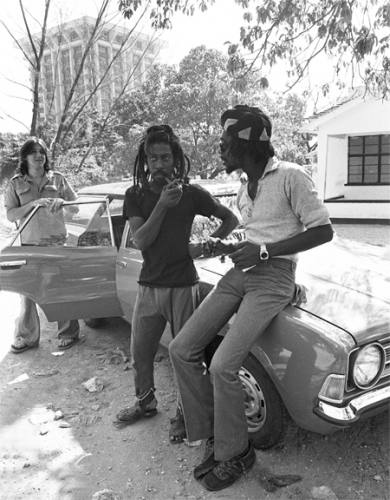
Peter Tosh, Bunny Wailer, and a young Cameron Crowe (Photo © Kim Gottlieb-Walker, www.lenswoman.com, all rights reserved. From her book “Bob Marley and the Golden Age of Reggae, 1975-76, The Photographs of Kim Gottlieb-Walker.”)
(WAR) How difficult was it to work with Bunny Wailer, a man who you could only summon by calling his name from under the coolie plum tree?
(KGW) “Bunny was great…he has a real aura of mystery and power…There is a story in my book about how he once refused to be photographed by a particular fellow because “I don’t let dead men take my picture” and the man died shortly thereafter – so I felt that the fact that he had no problem with me photographing him meant I would be around for awhile.”
(WAR) How has this experience affected or shaped you, both as a person and a photographer?
(KGW) “It certainly makes for some wonderful memories! I still think of Jamaica as a piece of the Garden of Eden and treasure my memories of that time and place. I am still the same “flower child” I was then….just chronologically older.”
(WAR) Are you a reggae fan?
(KGW) “I still occasionally listen to the reggae from the mid-seventies. All of the Wailers’ albums, Tosh…Bunny’s “Blackheart Man” is still one of my favorite albums…but my tastes are very eclectic and cover many different kinds of music. I rely on Jeffrey to turn me on to new performers. I never hear anything when I’m shooting, so I don’t remember the sounds of any concerts I shot.”
(WAR) What is your opinion of Bob Marley and the Wailers’ significance in the history of popular music?
(KGW) “Bob is an iconic figure around the world and that golden age in the mid-seventies produced amazing music. I know most people only think of Bob when reggae is mentioned, which is why I made sure so many others were also included in my book so their wonderful music can be discovered by those who only know of Bob… and remembered vividly by those who did know of them. I think Bob will be remembered as one of the most significant figures of the 20th century.”

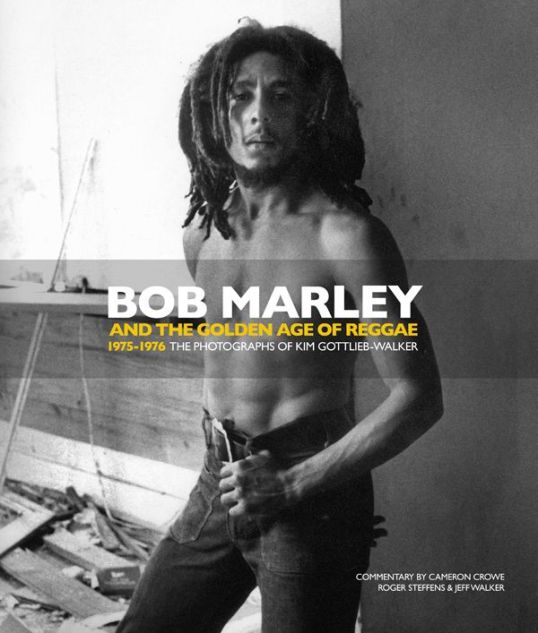
ACCESS MORE AT THE MIDNIGHT RAVER BLOG!




